 |
|

|
 |
TABLE of CONTENTS
 |
Eight projects to receive $17 million in Transportation Economic Development funds |
By J.P. Gillach
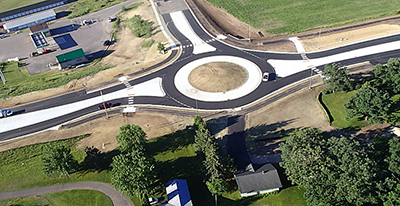
A previous TED project, on Hwy 95 in Mille Lacs County, completed in 2018. Submitted photo |
Gov. Tim Walz and MnDOT recently announced $17.4 million for eight construction projects in the Twin Cities Metro and Greater Minnesota to improve transportation infrastructure that supports economic growth. The projects are estimated to support more than 2,000 jobs.
“This round of Transportation Economic Development funding leverages local public and private funding to complete road projects that help create safe, vibrant communities, connect local businesses to their customers and supply chains, and connect people to jobs,” said MnDOT Commissioner Nancy Daubenberger. “The projects also improve local and regional safety, and demonstrate how a strong multi-modal transportation system supports healthy communities.”
The funding comes from the state’s competitive Transportation Economic Development (also known as TED) and Transportation Economic Development Infrastructure (also known as TEDI) programs. The programs target transportation infrastructure projects that create economic development opportunities and jobs through a collaboration between MnDOT, the Department of Employment and Economic Development, and local government and private sector partners. The TED program is administered by MnDOT and funding must be used for projects on state highways. The TEDI program is administered by DEED and focusses on local city, county and township roads.
“Infrastructure investments help businesses grow and make local communities attractive to companies looking to relocate or expand,” said DEED Commissioner Matt Varilek. “This partnership between DEED, MnDOT and local jurisdictions around the state illustrates our all-in effort to sustain Minnesota’s economic success.”
The projects selected are:
City of Waconia (TED, $5 million): Assist with completion of the Hwy 5 Phase 2 Reconstruction Project. The project will upgrade 1.4 miles of two-lane road to a four-lane divided road with multiple intersections through the eastern end of the city limits, close a 0.8-mile gap in the regional trail system, improve mobility and safety, and connect residents to more employment centers, including the nearby Ridgeview Medical Campus.
Dakota County (TED, $2.4 million): Improve the existing Hwy 52/Cty Rd 42 interchange in Rosemount, including adding new traffic signals and improving turn lane capacity from Hwy 52 onto Cty Rd 42. The project will improve safety in an area seeing increased truck traffic serving local companies.
City of Brooklyn Center (TEDI, $500,000): Reconstruct and replace streets and utilities on Opportunity Site to be redeveloped to accommodate a business incubator, a conference center and mixed income housing. The site is targeted for businesses owned by women, immigrants and Black, Indigenous and People of Color.
City of Hastings (TED, $2.73 million): Reconstruct Hwy 61 through Hastings. The project includes a new road system from 21st St to 25th St that will reduce traffic on local neighborhood roads, provide a local road system for industry and commercial access and improve trail system access that safely connects bike and pedestrian traffic to businesses in the area.
City of Norwood Young America (TEDI, $900,000): Construct streets and utilities to expand the Tacoma West Industrial Park. The 60-acre expansion will allow for approximately 14 new lots. The city has two committed businesses to locate in the park.
Carver County (TED, $3.2 million and TEDI, $500,000): Construct a new roundabout to improve safety and mobility at the Hwy 5/Cty Rd 11 intersection in Victoria.
Mahnomen County (TED, $125,000): Install new right-turn lane from Hwy 59 into the new Benson and Turner Foods plant bringing economic development to an underserved area within the White Earth tribal community. The turning lane is necessary to safely accommodate semi-trailer trucks and other vehicles turning from a high-traffic road into the business. Benson and Turner Foods is providing matching funds for this project.
Aitkin County (TED, $2.1 million): Construct a roundabout at the intersection of Hwy 65/Hwy 210/Cty Rd 8 in McGregor to improve safety and access to businesses and industries near the intersection, including numerous retail and hospitality, manufacturing, mining and trucking businesses.
An additional TED funding solicitation will open in summer 2024, with $4.4 million in TED funds available for projects exclusively in Greater Minnesota.
For more information on the TED program, visit MnDOT's TED webpage.
For more information on the TEDI program, visit the TEDI webpage. |
| |
|

|
 |
TABLE of CONTENTS
 |
Automatic deletion in Outlook to begin Jan. 29 |

Review the new policy to understand the new delete dates. |
By Megan Bauer, Office of Chief Counsel
MnDOT employees and third parties with a MnDOT email account have less than two weeks before old messages and attachments in Outlook are automatically deleted.
Beginning on Jan. 29, MnDOT will automatically delete any items in Outlook past their delete dates in accordance with the agency’s new email retention standard. Any messages and attachments stored in the Inbox or Sent Items folders will be deleted if they were received or sent more than two years ago. Messages and attachments more than 30 days old in the Drafts, Deleted Items and Junk Email folders will also be deleted. Outlook contacts, Tasks and Notes will not be affected by automatic deletion.
Emails stored in employees’ Archive folders in Outlook will have a delete date of 10 years after the date on the email. The MnDOT Information Governance Program encourages employees to use this folder if they need more time to review emails before they're automatically deleted.
“Automatic deletion of emails will help MnDOT focus on current and future issues,” said Jennifer W. Witt, Information Governance Program supervisor. “Allowing technology to do the work for us helps employees focus on important parts of their job and not spend time wrangling emails.”
Witt described automatic deletion in Outlook as “allowing the system to get rid of redundant, obsolete, and trivial communications without the end user having to lift a finger.”
Some MnDOT employees started automatic deletion in Outlook as early adopters in Oct. 2023. According to Technology Investment Management Program Manager Evan Iacoboni, automatic deletion has freed up time spent managing his inbox.
“It takes less time to properly file an email than it does to go back in time and try to find it,” said Iacoboni.
Visit the Microsoft Outlook Automatic Deletion SharePoint for more information about automatic deletion in Outlook as well as resources to prepare. Employees will continue receiving weekly email reminders until automatic deletion goes into effect. |
| |
|

|
 |
TABLE of CONTENTS
 |
Language Line provides assistance for translations needs |
By Mai Nhia Lor, Office of Communications and Public Engagement
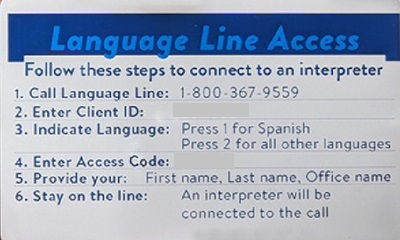
Language Line Access cards are available to MnDOT employees who interact with the public. Photo by Mai Nhia Lor |
Almost 12% of Minnesotans speak a language other than English at home, according to the State Demographic Center, so when state employees are working with the public, translation and interpretation are often important tools.
To this end, employees in all state agencies, including MnDOT, have free access to over 240 different language interpreters over the phone, through Language Line Access. The service can be used by adding the interpreter to a conference call or have them on speakerphone during face-to-face meetings.
MnDOT’s Offices of Communications and Public Engagement and Equity and Diversity MnDOT offers agency employees a Language Line Access card to help facilitate this service. The card can be easily carried in a wallet or inserted into the back of a badge for quick access. It includes important information such as the phone number, client identity number, access code and contact details for Janet Miller at OED, who oversees the Language Services for MnDOT. Miller also serves as the agency’s contact for other language services such as sign language, in-person interpreters or written translations.
“Effective communication and public engagement should not be hindered by language barriers,” Miller says, adding that Language Line is available “24 hours a day, 7 days a week, all year round."
The Office of Communications and Public Engagement will be sending 200 cards to each district to share with employees who interact with the public. Please get in touch with your Public Engagement/Communications Coordinators listed on this Contacts page to obtain the cards. If you have any questions regarding the Language Line Access card, please feel free to contact Mai Nhia Lor. |
| |
|

|
 |
TABLE of CONTENTS
 |
Khani Sahebjam returns to MnDOT as new Metro District Engineer |
By Christine Krueger, Metro
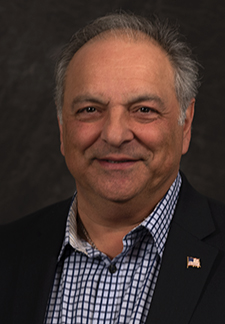
Khani Sahebjam is the new Metro District Engineer. Photo by Rich Kemp |
When Khani Sahebjam started as the new Metro District Engineer Jan. 2, he walked into the same building that he had exited in 2008. Much is familiar, including the title he held previously from 2003 to 2008, but he knows much has changed.
“I have gratitude for the work that’s been done for the public by people who worked here,” said Sahebjam. “History teaches us. We must build on that history and adapt to change.”
Sahebjam’s recent history includes 13 years in the private sector working in the transportation industry locally and nationally. The past five years he also served as President of the Minnesota Transportation Alliance and the Minnesota Society of Engineers and Surveyors. Prior to leaving MnDOT he served as the agency’s Deputy Commissioner/Chief Engineer from 2008-2011.
He is a graduate of South Dakota State University, where he earned both a Bachelor of Science in Civil Engineering and Master of Science in Structural Engineering. He’s married with two children and three grandchildren.
As Metro District Engineer, Sahebjam will lead 1,300 employees to implement MnDOT’s mission using high performance partnerships in the region to connect and serve all people through a safe, reliable, equitable and sustainable transportation system. Sahebjam’s office is located at the Waters Edge building in Roseville. He can be reached at khani.sahebjam@state.mn.us and 651-234-7700. |
| |
|

|
|

|
 |
TABLE of CONTENTS
 |
STEM Education and Outreach Lunch and Learn session shows employees how they can make a difference |
By Marcia Lochner, STEM Education and Outreach Program Manager

MnDOT employees try the Bridge-in-a-Bag activity during the Lunch and Learn session. In the classroom, the students typically build the bridge themselves and the employee’s role is to keep them on task and ensure they’re building safely. Photo via the Lunch and Learn recording |
MnDOT’s STEM Education and Outreach held a Lunch and Learn session on Dec. 12 to bring more awareness to the program and show employees how to get involved in these efforts and make a difference for students across the state. Attendees learned about the program’s offerings and support from MnDOT Leadership, as well as personal experiences from employees who have participated in the past. The session also included a demonstration and hands-on experience for the program’s Augmented Reality Sandbox and Bridge-in-a-Bag activities that are used in classrooms across the state. A video recording of the event is available to watch on the MnDOT YouTube channel.
MnDOT’s STEM program began in 2017 to increase K-12 student awareness to science, technology, engineering, and math (STEM), and other MnDOT careers at a young age. The program offers many online and in-person resources to students, educators and the public, including curriculum, activity books, classroom activities (such as Bridge-in-a-Bag, in which students build a six-foot-long bridge), career panels, touch-a-truck events, science fair judging and mentoring, and community visits. To date, the agency have participated in at more than 400 events and reached more than 225,000 students and educators through in-person outreach.
Agency employees from all backgrounds use paid MnDOT time to participate in these educational and rewarding classroom and community events year-round and across the state. All MnDOT employees are eligible and encouraged to participate; many (if not most) of these events need no previous experience and are low-key and easy for employees.
As Michael Beer, assistant commissioner, Engineering Services Division, shared during the session, “I want to challenge you. If you’re a supervisor, challenge your employees when you have a performance review to set a goal for next year to get out one time to do a STEM event. If you’re an employee, talk to your supervisor about opportunities if they don’t bring it up to you, and remember these are paid events.”
While these events create a lasting impact for students and MnDOT, participating employees also report finding them personally rewarding in many ways, including their own professional development and building relationships within MnDOT and their community.
Jay Hietpas, assistant commissioner, Operations Division, recalled the impact MnDOT outreach had while he attended college: “I look back at the days when I was at the University of Minnesota and MnDOT would come out and talk with us. It meant a lot to me when MnDOT was there and when I graduated, MnDOT was number one on my list just because they were so engaged, and it was great to be able to interact with those staff. I think you’re going to find it super rewarding to go out there and talk to people for your own personal experience and to grow that future workforce.”
Another way that employees can get involved is by helping to spread the word of these resources with schools and other educational organizations to which they have a connection.
How can you get started? The STEM program has many opportunities for employees to sign up for today and at any given time. To see what is available, visit the STEM calendar at any time and email Marcia Lochner if you are interested in signing up for any events or fill out the ambassador form to get on the ambassador list and be notified of future opportunities. As part of the MnDOT Team, your willingness to share your time and knowledge with Minnesota students is invaluable and continually appreciated.
To learn more, visit the STEM iHUB site, or reach out to Marcia Lochner or any of the district or office STEM outreach representatives. |
| |
|

|
 |
TABLE of CONTENTS
 |
New Library Materials now available |
| By Madeline Kuncio, MnDOT Library
The latest issue of New Library Materials is available. This month’s collection close-up book is “Right Kind of Wrong: The Science of Failing Well” by Amy Edmondson. This book was featured in the Jan.-Feb. Office of Equity and Diversity Newsletter.
New Library Materials is a compilation of resources added to the library collection during the previous month. Visit our Stay Current page and click New Library Materials to sign up. Questions and feedback are welcome at Ask a Librarian. |
| |
|

|
 |
TABLE of CONTENTS
 |
On the Job: Casey Carlson helps aircraft fly and land safely |
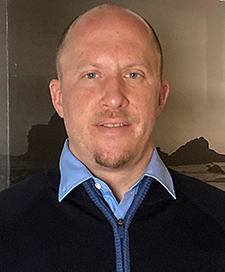
Casey Carlson |
By Joseph Palmersheim
Casey Carlson works as a navigation systems coordinator in MnDOT’s Aeronautics Office. The five-year employee started his career with the agency in District 2.
What do you do in your role?
I work with a team of incredible co-workers to keep aviation navigation systems, or “Nav Aids,” operational. If I asked you to close your eyes and imagine what navigation aids you would see at an airport, you would probably think of a lighted windsock up on a pole, or perhaps the green/white rotating beacon spinning during the night, or some pretty lights shining alongside the runway.
Each is a “Nav Aid,” designed to show conditions on the ground for an approaching aircraft or to help escort the pilot to a safe landing. There are lighting systems aimed up into the sky to tell the pilot that they are on the correct glide path down to the runway. There are also bright, flashing lights to help the pilot find the start of the runway. Most airfields have weather equipment so pilots can check the current conditions. Finally, some of the larger airports will have complex radio navigation systems. Radio signals from ground-based systems at certain frequencies to help with navigation and most importantly, safe landings.
MnDOT’s NavAid team inspects these systems at airports around the state. On the day of the inspection, the FAA gives us a window of time when to expect them at the site requiring service, and we arrange to have a ground technician onsite. The FAA aircraft will radio down to us on a special frequency from about 20 miles away, and then they make several passes. As they pass, the crew communicates tells the ground support team what minor adjustments need to be made prior to the next pass. It lasts a few hours on a good day, but it can take a full day for more complex systems.
How has your field changed in the time you’ve been in it?
I came in at the tail end of LED lighting technology making its way onto airports. Most new systems installed today are LED, but there are still some incandescent stragglers out there. One example are the steady-burner bulbs in some of the approach lighting systems. In low-visibility conditions, it is important that the bulbs are dependable, because low visibility is when you need them most. Also, they are an “open lamp” exposed to the elements, so they are subject to frost/ice buildup. The lamp must burn hot enough to melt itself clear or have some other means of heating up the front lens. There isn’t much time for this to happen, as the pilot doesn’t engage the lighting system until they are just a few minutes or so from landing the aircraft down on the runway.
What do you find interesting about your work?
A few interesting things that I learned when joining the Aeronautics team:
- What an important localized weather reporting is for the flying community. We have all seen a thunderstorm come by and “just barely touch” the location you are at, but the storm hammers the next community over. Pilots need to know as accurately as possible to best navigate the skies and avoid storms.
- How pilots can control lighting systems on the ground, like runway edge lights. There is a ground-based radio receiver smaller than a suitcase and hooked to an antenna on top of the NavAid shelter. If a pilot pushes buttons on the airplane’s navigation radio in a certain way, the radio receiver on the ground can interpret the information and initiate the appropriate reaction. The system adjusts the intensity of the whole lighting system on the ground. After 15 minutes, most of the lights on the field will revert to low intensity or shut off until they are needed again.
- Certain navigation systems at our airports require a periodic inspection, including a commissioning inspection of a brand-new system. The only source for this type of inspection is the FAA. Another example would be restarting a radio navigation system that has drifted out of acceptable tolerances. In such cases, the system needs to be “re-approved” for use by the flying public. When that happens, our MnDOT Navaids team reaches out to the Flight Safety section at the FAA to line up a flight check. The FAA operates a fleet of Twin Turbo Prop Beechcraft King-Air airplanes fitted with special instruments that can measure the systems on the ground from up in their aircraft.
How did you become interested in aviation?
I didn’t know I was, initially. As a licensed electrician, I spent most of my time in the construction and maintenance of commercial buildings. I was always keeping an eye out for the next challenge or opportunity, and I was blessed to have an opportunity to cross over where my electrician background meets airports. Since joining the team, I feel like I have found my “career home” and plan to be a part of this team for many years into the future.
What did you want to be growing up?
A childhood friend and I both said that we “are going to be lawyers.” Only one of us did that. He is doing fantastic as a corporate lawyer in a big city. Poor fella.
Do you or a co-worker have an interesting job to share with readers? Send us your ideas, and we’ll contact you for more information.
Recent employee profiles:
|
| |
|

|
 |
TABLE of CONTENTS
 |
MnDOT and the Local Road Research Board address emerging transportation challenges through new research |

A newly funded project determine the feasibility of sustainable practices that are cost-effective, replicable and can be effectively and efficiently incorporated into safety rest areas. Drone photo by Rich Kemp |
By Micaela Kranz, Office of Research & Innovation
MnDOT and the Minnesota Local Road Research Board have funded 21 new research projects and are seeking volunteers to serve as Technical Advisory Panel members and help guide the research. This year’s RFP received more than 83 proposals from qualified universities across the country.
Researchers will address transportation challenges such as:
"We take pride in MnDOT's comprehensive research program,” said Katie Walker, MnDOT Research & Innovation director. "This assortment of new research projects is dedicated to addressing a diverse range of high priority, emerging transportation issues. These projects underscore our commitment to ensuring transportation solutions that prioritize safety, promote equity and contribute to sustainable practices. Our gratitude extends to the numerous contributors involved in this collaborative process."
Each spring, the MnDOT Research Steering Committee and the Minnesota Local Road Research Board solicit research ideas from transportation practitioners and later request proposals from universities. In December, the research governing boards meet to hear these proposals and select projects for funding. To receive updates on any of the funded projects, select “subscribe” on the project webpage. To volunteer for a project advisory team, contact MnDOT Research.
Have an idea for MnDOT's next funding cycle? Visit IdeaScale to submit your idea, the deadline to submit is April 1.
|
| |
|

|
 |
TABLE of CONTENTS
 |
District 7 and TZD employees give back to the community |
By Doris Degenstein, District 7

MnDOT employees serve the state in all kinds of ways, and some recently went the extra mile to help those in need by participating in blood drives. District 7 and the State Patrol organized a blood drive in Mankato on Jan. 16, where participants included Bryan Lillie, MnDOT District 7 maintenance superintendent, pictured here. In December, some employees participated in the TZD Conference Blood Drive, which collected a total of 17 full units of blood. Photo by Doris Degenstein, District 7
|
|
| |
|

|
 |
TABLE of CONTENTS
 |
District 6 employee takes reporter for ride along |
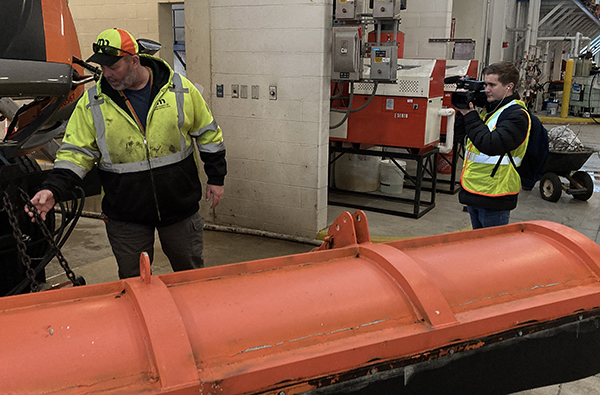
Steve Kazeck, District 6 snowplow operator, showed a KTTC-TV reporter how he conducts a safety check of his snowplow prior to getting behind the wheel. The reporter did a ride along with Kazek on Jan. 9 during his afternoon shift on Hwy 52 in Rochester after a snow event. Photo by Mike Dougherty
|
|
| |
|

|
 |
TABLE of CONTENTS
|
Name That Place Puzzler #17 |
By Doug Mack
Can you name the place pictured below? The ground-level photo is from Google and the satellite image is from the 511 website and app. For this location, we’re looking for the name of the highway and why this particular stretch is notable.
If you think you know the answer, email Newsline editor Doug Mack. The first three people to submit the correct answer will receive the fame and glory of having their names listed in the next issue of Newsline.
Answer to the last Puzzler: Kenney Lake Overlook. The first people to get it right were Patrick Gilbertson (Office of Land Management), Micah Holzbauer (Office of Materials & Road Research) and Barbara Allan (Metro). Congrats to them and thanks to everyone who played!
Special thanks to Ken Hansen (District 3), who suggested this location. If you know a place that would make a good Puzzler, please get in touch!
|
 |
|

|
 |
TABLE of CONTENTS
 |
Message from the Commissioner: MnDOT’s strategic goals for 2024 and beyond |

Commissioner Nancy Daubenberger. |
By Commissioner Nancy Daubenberger
EDITOR’S NOTE: The following article is adapted from an email that Commissioner Daubenberger sent to all employees Jan. 5.
As we begin another new year, I am pleased to share with you the final copy of the MnDOT 2023-2027 Strategic Plan, which will help guide us in fulfilling our mission to ensure that Minnesota’s multimodal transportation system maximizes the health of people, the environment and our economy. This plan is the product of much work and collaboration across our entire department and I am thankful to all who offered suggestions and ideas as we updated this document.
While we inevitably will face critical transportation challenges in 2024 and beyond, we also know that MnDOT is not alone in tackling these challenges. We accept the responsibility, but also recognize the incredible opportunities we have to engage with and learn from efforts happening nationally and within Minnesota. We have developed a plan that is specific to MnDOT but provides support for broader transportation policy and investment initiatives. This plan aligns with the Governor and Lt. Governor’s One Minnesota Plan, the USDOT Strategic Plan, our State Multimodal Transportation Plan and our Agency Risk Register.
Below are some key details of MnDOT’s 2023-2027 Strategic Plan.
Mission
Minnesota’s multimodal transportation system maximizes the health of people, the environment and our economy.
Vision
Connect and serve all people through a safe, equitable and sustainable transportation system.
Values
Our values guide how all MnDOT employees show up each day on behalf of Minnesotans.
- Safety – We recognize safety is core to our work and build it into everything we do.
- Service – We take pride in our work and hold ourselves to the highest standards.
- Equity – We actively remove barriers to create an inclusive transportation system that benefits all.
- Sustainability – We act today to contribute to a better transportation system of the future.
- Innovation – We search for new ideas, experiment to learn and grow and create value for the public.
- Collaboration – We leverage the contributions of our team members acknowledging the impact we can have together.
Goals
- Promote a Safety Culture
- Advance Transportation Equity
- Champion Sustainability Actions
- Maximize Stewardship of Resources
- Foster a Thriving Workforce
While each goal has key objectives, strategies and performance measures identified, this plan is meant to be a living document that we can refine over time as we apply lessons learned and expand our expertise. As we have in the past, we’ll incorporate these goals and values into documents like our business plans.
There will be more information in the coming months regarding implementation activities.
In the meantime, I ask that you take some time to review the full document and reflect on how you can incorporate this strategic direction in your day-to-day work.
Thank you for all you do on behalf of our agency and the people of Minnesota.
|
| |
|
|
|



